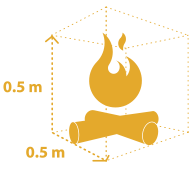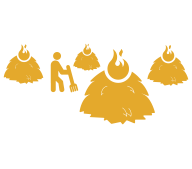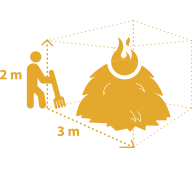Open fire and safe burning
Open fire—or burning outdoors—is allowed when the wildfire risk is low and can be a useful tool when conducted responsibly. Even if there are no provincial open fire prohibitions in place, check with local government authorities for any other open fire restrictions.
On this page
- Category 1 campfires
- Category 2 open fire
- Category 3 open fire
- Category 4 resource management open fire
- What to do before you burn, including burn registration
- Regulations and fines
British Columbia is large and geographically diverse province. For that reason, decisions on when and where to implement fire prohibitions and restrictions are made by B.C.’s six regional fire centres.
Multiple factors are taken into consideration when assessing wildfire hazards and deciding whether to implement an open fire prohibition, including: current and forecasted weather conditions; the availability of firefighting resources and the Buildup Index (BUI).
Open fire includes Category 1 campfire, Category 2 and Category 3 open fire and Category 4 resource management open fire.
Category 1 campfire
A campfire is defined as:
- Any fire no larger than 0.5 metres high by 0.5 metres wide (a fire larger than this is considered a Category 2 fire).
- Used by any person for recreational purposes or by a First Nation for a ceremonial purpose.

View the category 1 campfire poster (PDF, 4.6MB) or the category 1 campfire brochure (PDF, 5.4MB) for information on responsible campfire use.
Avoid having a campfire when it's windy, choose a proper fire pit or make a ring of rocks at least three metres from trees, shrubs, structures and debris, and do not leave a campfire unattended for ANY amount of time.
Category 2 open fire
This category refers to fires, other than a campfire, that burn:
- Material in one pile not exceeding 2 metres in height and 3 metres in width
- Material concurrently in 2 piles each not exceeding 2 metres in height and 3 metres in width
- Stubble or grass over an area that does not exceed 0.2 hectares
View the category 2 open fire poster (PDF, 11.1MB) or the category 2 open fire brochure (PDF, 14.4MB) for more information on safe open burning practices.
Category 3 open fire
This category means an open fire that burns:
- Material concurrently in 3 or more piles each not exceeding 2 metres in height and 3 metres in width
- Material in one or more piles each exceeding 2 metres in height or 3 metres in width
- One or more windrows, none of which exceed 200 metres in length or 15 metres in width
- Stubble or grass over an area exceeding 0.2 hectares

View the category 3 open fire poster (PDF, 6MB) for more information on safe open burning practices.
Category 4 resource management open fire
This category refers to prescribed fire. Prescribed fire describes the deliberate use of fire to achieve a range of land stewardship objectives. It can help reduce the intensity of naturally occurring wildfires while returning an integral process to the land base.
These fires can take many months or even several years to plan, depending on the size, complexity and objectives the proponent is trying to achieve.
Common objectives include:
- Public safety and wildfire risk reduction
- Improved wildlife habitat
- Revitalized vegetation and ecosystem health
You can learn more about prescribed fire in B.C. at prescribedfire.ca.
Before you burn
Before lighting a fire, even if the burn category is not currently prohibited, ensure you are properly prepared, aware of the conditions and following open fire regulations:
- Establish a fuel break around your Category 2 or 3 burn or fire guard around your campfire.
- Ensure someone is always monitoring the fire so it doesn't spread beyond its intended size. At least one person equipped with a fire-fighting hand tool must monitor the fire at all times.
- Do not burn when venting conditions are "Poor" or "Fair"
Anyone lighting a Category 3 fire must first obtain a burn registration number by calling 1 888 797-1717. These numbers are logged into the Open Fire Tracking System (OFTS) along with details about the registered burn.
Unsure if you need to register your burn? Want to know what your legal obligations are when open burning? Learn more about registering a burn.
More information on open fire regulations and safe fire use is available in the Industrial & Resource Management Burning pamphlet (PDF, 215KB) or the Open Burning Practices for Farmers and Ranchers factsheet (PDF, 5MB).
Regulations and fines
Anyone found in contravention of an open fire prohibition may be issued a violation ticket for $1,150, required to pay an administrative penalty of up to $10,000 or, if convicted in court, fined up to $100,000 and/or sentenced to one year in jail. If the contravention causes or contributes to a wildfire, the person responsible may be ordered to pay all firefighting and associated costs. Violators could also be held responsible for damages to Crown resources, which could be significant. Read more about the Wildfire Act and Regulation.
Why doesn’t the BC Wildfire Service just ban all open fire during the spring and summer?
Fire is a very useful tool when used responsibly, so it doesn’t make sense to ban all forms of burning when the wildfire risk is low. During the spring, farmers and ranchers may conduct controlled burns for agricultural purposes and the forestry industry conducts “slash” burning to remove wood debris left behind after timber harvesting. British Columbia is also renowned for its great outdoors and many enjoy campfires while camping in B.C.’s parks and recreation sites. Many tourism operators also offer wilderness experiences that include campfires.
Anyone lighting a Category 3 fire must first obtain a burn registration number by calling 1 888 797-1717 or emailing hpr.1800@gov.bc.ca.
To report a wildfire, unattended campfire or open burning violation, call 1 800 663-5555 toll-free or *5555 on a cellphone.

